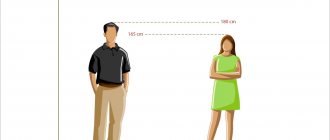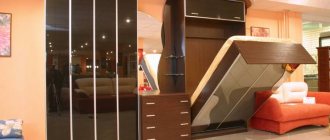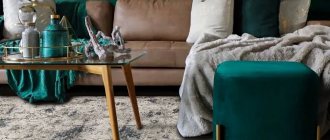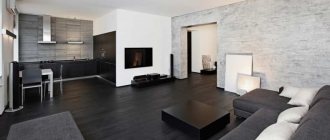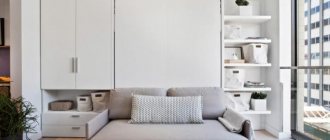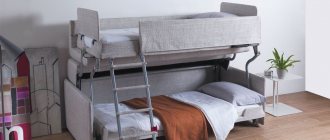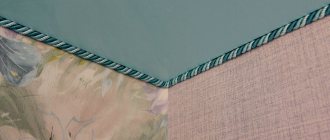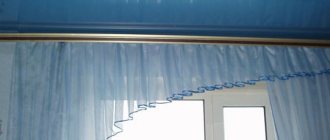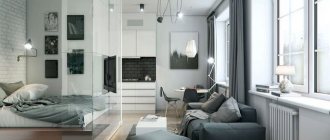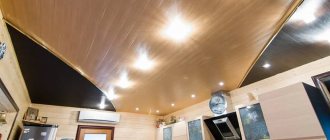Combined ceiling made of plasterboard and stretched fabric in the living room
The ceiling in the room takes up a considerable area, so its finishing should be approached responsibly. Sometimes, even a carefully thought-out interior looks unfinished if the surface above is not involved in creating the overall appearance of the room.
The options for finishing the ceiling are varied, and choosing the most suitable material in accordance with the design concept, level of complexity in manufacturing and financial capabilities is not difficult. The most common methods of finishing the ceiling, which will be confirmed by appropriate photos, will be discussed in this article.
Which ceiling to choose
It’s not for nothing that there are so many types of ceilings - each of them solves certain problems, meets its own criteria and tastes of different people. But such a huge selection and availability of most materials can be confusing - you want both this and that.
But this surface is finished once every few years, and it’s good if over the years it doesn’t get boring, doesn’t deteriorate, and doesn’t go out of fashion. Is there a design that meets these requirements? Yes, there is one!
An example of versatility
A common option that fits into most interior styles is a matte white surface. At the same time, it should be smooth, without drawings or stucco.
There are many types of materials that can look like this. This includes drywall, paint, plaster, and even suspended ceilings of a certain texture. Here the choice depends on what budget you have allocated for repairs, how long you are willing to wait and how much inconvenience you are willing to endure for the sake of the result.
In what cases can complex ceilings be made?
Designers most often recommend adhering to the principle “the simpler the better,” but there are exceptions:
- If the decoration of the room and the furniture in it are neutral both in color and shape, the ceiling can, and sometimes even needs to be made unusual. But if the room already has enough accents, then the top should be more modest.
- In large rooms, multi-level structures look great, zoning the space and making each part more separate. The shape of the ceiling depends on what is located on the floor and walls. For example, you can lower the ceiling above the bed. In this case, rearranging the furniture will be much more difficult, so its location needs to be carefully thought out.
- Ornate designs overhead - various waves, flowers and butterflies - will not soon become relevant. In modern interiors, simple geometric shapes are more common - square, rectangle, circle, semicircle, oval, triangle. Multi-level ceilings of similar shapes are used when it is necessary to correct the irregular shape of a room. In this case, their use is justified.
Whitewash, paint and plaster
To paint, whitewash or plaster the surface, you will have to tinker, but the height of the walls will remain the same. These finishing options are suitable for most styles - classic, modern, historical, rustic, ethnic.
Lime and chalk
Despite the fact that the range of finishing materials is becoming larger and larger, the good old whitewash has not gone away. Its composition is very simple - it is an aqueous solution of slaked lime or an aqueous solution of chalk. The characteristics of these solutions differ. Lime has the following properties:
| Pros of lime | Cons of lime |
| Hides minor surface defects well | The color is white, but not bright |
| Has bactericidal properties | It smells unpleasant during the whitewashing process, but after drying there is no smell |
| Resistant to moisture | May cause allergies |
Chalk has its advantages and disadvantages:
| Pros of chalk | Disadvantages of chalk |
| Paints ceilings and walls bright white | It does not have the same masking qualities as lime, so the surface will have to be more carefully prepared for whitewashing |
| Has a neutral odor | Not bactericidal |
| Hypoallergenic | Not suitable for wet environments |
IMPORTANT . If the ceiling has already been covered with lime, then in the future you need to use such a solution. And if the surface is covered with chalk, then the new layer should be chalk. But chalk and lime are incompatible.
Dye
Water-based matte paint is best suited for painting the top - it is odorless and dries quickly. As for preparing the surface for painting, people here are divided into two camps - supporters of perfectly smooth ceilings and those who calmly paint directly over concrete or rough putty. But there shouldn’t be any controversy here - it’s just that some trends in interior design really allow for slight negligence.
Plaster - textured and structural
Textured plaster allows you to create the desired relief on a layer that has not yet dried. Only those specialists who have at least some artistic abilities should be involved in such work.
And the pattern of structural plaster manifests itself during the process of applying the solution. This happens thanks to the special components in its composition.
Careful leveling of the plane is not required - plaster will hide the imperfections. This coating is environmentally friendly and durable.
This decorative plaster on the walls and ceiling creates the illusion that the house is built of sand
Painting
For those who strive for ease of maintenance, durability and reliability of design, painting is the best option. Do you think this method is economical and very simple? This also has its own characteristics.
Painting is considered a popular and simple option.
For painted ones, preliminary preparation is required. The surface must be leveled and all irregularities eliminated. In order for the room to be pleasing in the future, leveling must be carried out professionally, using starting and finishing putty.
The choice of paint is the next important point. Water-based paint with a matte effect is often used for decoration.
The main thing is to choose the desired color
Water-based paints can be of different colors, which allows you to use a combination of several shades. Both light, familiar to the eye, and rich glossy shades are suitable for the ceiling.
The color for painting can be either light or dark
For a child's room, preference should be given to hypoallergenic compounds. Some types of paint are available with additional enrichment with silver ions.
Paints are produced that successfully imitate the appearance of a glossy stretch ceiling.
For those who want to diversify their interior, we can recommend paints that reproduce unusual textures and effects:
- old age;
- type of natural clay;
- craquelure, etc.
Commonly used concrete effect
Wallpaper
Let's look at some types of wallpaper suitable for ceilings.
Paper, vinyl, non-woven and textile
Paper wallpaper is the most budget-friendly. And if the choice falls on them, then it is better to prefer two-layer ones - the image on them can be either flat or convex. Paper is the most environmentally friendly and breathable finishing material, but that’s where its advantages end.
Non-woven wallpaper is divided into two subtypes - completely non-woven and combined. The latter have only a non-woven base, and the outer side can be vinyl or some other.
BY THE WAY. Wallpaper consisting entirely of non-woven fabric can be painted, and more than once.
Vinyl wallpapers are denser, but they are rarely painted. In addition, this type of canvas is not recommended for use in the kitchen - it absorbs odors.
Textile wallpaper looks cozy and presentable, but you should not try to glue it yourself without experience.
ADVICE. If you have to choose between wallpaper and paint, experts advise taking into account the age of the house. New buildings shrink during the first few years and microcracks appear on the surfaces. And good wallpaper can hide them. And it is better to use paint in houses that are more than 5 years old.
If the ceiling is high enough, choose a large wallpaper pattern - then you can examine it in detail
Liquid wallpaper
This material is a dry mixture of textile fibers and cellulose. Before applying to the surface, the mixture is diluted with water. The advantages of liquid wallpaper are the absence of seams and maintainability. If any area is damaged, it can be “patched” with the remaining mixture.
BY THE WAY . The design of fillets—plinths made of foam plastic or other materials—helps to achieve a neat boundary between the ceiling and the wall.
Liquid wallpaper can be tinted yourself if the desired shade is not available for sale.
What's trending today
Modern design is such a wide field of application of various technologies and materials that almost any idea can be realized. Urbanization and glamor have recently faded into the background, giving way to conciseness and simplicity of design implementations.
The canvas can be decorated in various ways
Naturalness is one of the trends. This design involves single-level ceilings that look neat. A similar effect is achieved by high-quality plastering or the use of drywall.
Even if your ceiling after renovation is simply smooth and white, it is in trend. But this trend does not mean that multi-level ones are a thing of the past; they are still relevant. They are used not only in living rooms, but also in children's rooms, bedrooms and spacious hallways.
Multi-level ceilings are still in trend
Which ceiling to choose: painted, suspended or some other? To form your own opinion, consider each type. Let us highlight the pros and cons of various coatings, both from the point of view of operational properties and from the point of view of interior design.
Facing materials
The cladding will hide unevenness well, and will take away quite a bit from the height of the room. Materials for the top differ in their properties from those intended for walls. Firstly, they should be as light as possible. Secondly, strength is not so important for them.
Ceiling tiles
The advantages of this three-dimensional tile imitating molding are its low weight and low price. This material may look beautiful, but is often used to save money and time. The tiles are installed quickly - just glue them to the surface with special glue. At the same time, it must be applied carefully - only to the middle of the tile - without allowing it to leak out along the edges.
Expanded polystyrene tiles come in three types: pressed, laminated and seamless. Laminated is a suitable option for the bathroom and other wet areas. Seamless is good for the living room and other living rooms. Pressed tiles are the most fragile.
IMPORTANT. In kitchens with a gas oven, any polystyrene foam tiles will quickly lose their appearance.
The most common type of ceiling tile
Brick
Real brick is used only for the construction of vaults. But the facing is also suitable for decorative finishing of the top. Alternative options are also used - from drywall, plaster or carved foam.
Brick can be painted any color
Recommendations for choosing finishes
When choosing the material and method of ceiling installation, you should take into account the height of the room and existing surface defects. Lighting plays an important role, affecting the visual increase or decrease in the height of the room. When choosing a ceiling finish, you need to adhere to moderation in color scheme. The upper part of the room should be in harmony with the overall style of the room.
To finish the ceiling surface in the gazebo, you can use wood lining. The bathhouse can also be decorated with such material. For covering the ceiling space in the corridor, suspended ceilings, liquid wallpaper, and polystyrene tiles are suitable. When deciding how to decorate the ceiling on the veranda, it is recommended to give preference to plastic panels or slatted aluminum profiles. In the hallway, you can decorate the ceiling using a plasterboard structure or decorative plaster.
Stretch ceilings and their types
Such designs come in handy when you need to do work quickly and relatively cleanly, and at the same time hide communications, install lamps and protect the room from flooding. You will have to pay for these amenities with the height of the walls - they will become at least three centimeters lower.
Let's consider different types of such surfaces.
Glossy
Varnish, or glossy, PVC ceilings are a very popular solution. They are reflective, which means they make the room brighter and visually higher. But they don’t look good in every interior. An exception may be styles such as high-tech - here gloss will emphasize the idea of manufacturability.
Black gloss reflects the chandelier, making it seem more voluminous
Matte and satin
If your goal is to create a surface similar to a classic one, give preference to a matte texture. Satin also looks almost natural and only slightly reflects the light falling on it. This is a compromise between a glossy and matte surface.
This matte cream-colored stretch ceiling is almost indistinguishable from painted
Stretch ceilings protect the room from flooding from above
Suede
The upper, trimmed with suede, looks interesting in rooms furnished in ethno, baroque, classic or retro style. Even in a large room, such decoration will create an intimate atmosphere. There are also materials that imitate leather.
Such a bright suede ceiling needs space
With photo printing
The photo printing technique allows you to apply any design to the canvas at an affordable price. But it is better to use this opportunity carefully. In the vast majority of cases, such ceilings look out of place, especially if an ordinary photo is chosen as the image, and not a work by an artist.
If you want a salamander on the ceiling - no problem, photo printing can do that too
carved
Such surfaces with a 3D effect do not go unnoticed. Here two or more canvases are combined. What is below has shaped holes through which the first layer is visible. A huge number of design and color options allows you to create both a real masterpiece and something that will add to the collections of “anti-trends” on YouTube.
Flying swallows - a suitable image for a carved ceiling
Mirror
Unlike glossy samples, which loudly declare that they are tensioned, mirror ones look like real mirrors. Only they are darker, but absolutely unbreakable. Their already sufficient decorativeness can be enhanced by applying patterns to them. For example, abstract matte lines or pictures
There should be order in a room with mirror surfaces
This video shows the so-called “floating” tension structures. Lighting plays a big role in creating this effect:
Plastering
Decorating the ceiling with plaster mixtures is also a fairly popular procedure. Using this material you can not only decorate the surface, but also level it. In addition, plaster compositions do not burn and do not support combustion, do not emit toxic substances, and are relatively inexpensive.
Important! Such work requires two people, as well as some experience - it will be difficult for a novice home craftsman to do everything perfectly smooth.
Finishing the ceilings in an apartment with plaster is impossible if the ceiling is more than 5 cm thick. Too large a layer of material can significantly reduce the service life of the coating. In addition, the plaster “steals” the height of the walls a little.
Dropped ceilings
The above-mentioned tension structures also belong to suspended structures, but they are usually classified as a separate group. Next we will list other types of suspended ceilings. There are many of them, but they all differ in that they are attached to the main floor, hiding both various irregularities and communications underneath.
Rack and pinion
A stacked ceiling made of aluminum, wood and other slats is an unusual and quite durable option. Depending on the type and material, it may look different.
Slats add geometricity to the interior
Plastic panels: to use or not
This material is considered modern and can be up to 0.4 m wide. The surface of the panels is used for decoration, both smooth glossy and textured. This finish looks very attractive, is resistant to fading in the sun, is non-toxic, and can be wet cleaned.
Plastic can be varied in shape and texture
Plastic can be placed not over the entire area of the space, but to highlight certain areas, mask electrical wiring or supply pipes. The characteristics of the material include fragility, which can manifest itself even at the installation stage.
From the floor to the top
Conventional flooring can also end up on other planes. Among such universals, the first places are occupied by laminate and cork.
Laminate
There is no special ceiling laminate - the same one used for the floor is used. At the same time, you can safely choose not the most durable types, because the load on it will be small.
Preference is given to the lightest colors - white, grayish, yellowish and beige. The wood-imitating coating has shades such as white oak, light walnut and ash. In tall and well-lit rooms, you can safely use dark colors.
ADVICE. There is no need to use the same shade of laminate both below and above - such an interior will turn out to be too monotonous and flat.
Laminate can also imitate metal, stone, concrete and other materials. And, if “wood” is suitable for a modern style, then “metal” will look great in a high-tech interior, “stone” in a Gothic setting, and “concrete” in a loft.
Laminate flooring on a high ceiling can easily be confused with natural wood
Cork tree
Another option for finishing the ceiling is to use balsa wood. This material has the following advantages:
- environmental friendliness;
- variety of shades;
- thermal insulation;
- soundproofing;
- small thickness;
- the ability to bend panels in order to trim various protrusions with them;
- resistance to fungus;
- water resistance.
One of the disadvantages is that the cork must be coated with wax or varnish. This material is difficult to work with and there is a risk of damaging it during installation. Therefore, it is impossible to do without professionals.
This cork ceiling is especially good for living rooms
Hemmed construction
Let's talk about another type of finishing - hemming. This is a fairly affordable way to improve the decor.
Why is it called that?
The sheathed structure seems to be hemmed to the frame located on the main interfloor slab. In this way, you can qualitatively level the surface without significant costs.
This type of top is not suspended, which means that it can be used to avoid lowering the room. At the same time, the main advantage of suspended structures will not exist, namely the ability to hide communications.
Wooden false ceilings are more often used in country houses than in apartments
What can such a top be made from?
To create a hemming structure, the following materials are used:
- Drywall. This material is pliable and easy to work with; thanks to these qualities, the coating can be built quickly and independently. After installation, the drywall needs to be puttied and painted.
- Plastic or metal slats. These materials are especially good for wet areas. The advantage is that neither plastic nor metal require additional finishing.
- Decorative panels made of polyvinyl chloride or expanded polystyrene. They are light and inexpensive and easy to work with.
- Tree. In a country house, wooden surfaces are often made. They are in harmony with the walls made of timber. The boards will need a protective coating - colored or transparent.
The top can also be decorated using MDF or laminate.
There may be several types of ceilings in your apartment or house. One variety will be good for the living room, the second will be suitable for the corridor, and the third will serve well in the kitchen. Pay attention not only to aesthetics, but also to the practicality of coatings.
Video description
For more information on how to decorate the ceiling in a wooden house with clapboard, watch the video:
Further along the bottom of the guide beam from wall to wall, a nylon thread or fishing line is pulled as a “beacon”. This is necessary for alignment in the plane of the supporting structure. The supporting beams are attached at an equal distance, guided by a stretched fishing line.
Fastening the lining to the frame Source emupauto.ru
All that remains is to fasten the lining panels to the frame: the first strip and all subsequent ones are attached to the sheathing at the points of contact with nails or small screws. To tightly join the panels together, you can use a rubber hammer.
It is impossible to sheathe the ceiling close to the walls and load-bearing elements. There should be a small gap in case the wood expands as humidity increases. The gaps can be covered with decorative plinth.
Slatted ceiling made of lining Source kakpotolok.ru


